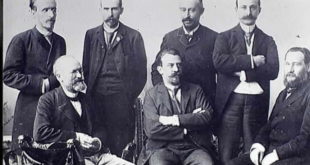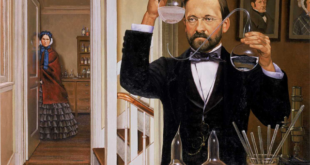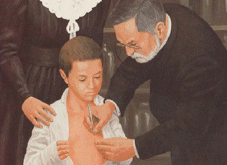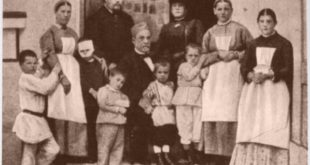Originally published in “The Rotarian” magazine in June, 1937
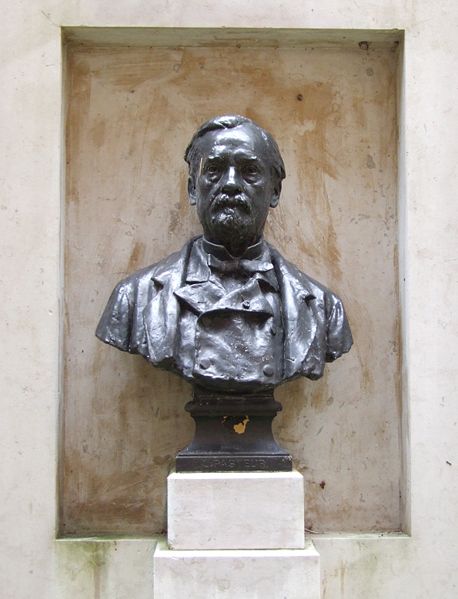
A little more than a century ago—December 27, 1822—in, the humble dwelling of a tanner in Dôle, France, a child was born who was destined to create new sciences, to transform industries, and to bring the greatest relief to human miseries: Louis Pasteur.
Pasteur had just graduated from the Ecole Normale when he demonstrated the relation which existed between rotatory power and molecular dissymmetry. This work was the origin of that stereochemistry later associated with the names of Le Bel and Van’t hoff.
The man whose name is associated with the saving of lives from mad-dog bite, and with safeguarding the lives of babies through the pasteurization of milk and of other dairy products, was born and lived in France. Indomitable in courage, persistent, patient, he pursued his studies for the welfare of mankind despite the jibes of the scoffers and reactionaries of his time. The story of his life is an epic of service above self.
No story of Louis Pasteur would be complete without mention of his splendid wife, a woman of rare intelligence and courage. The daughter of the president of the university in which Pasteur was a teacher—Strasbourg University—she understood from the first the kind of man she had married. Her devotion to relieving him from everyday cares left him more free for scientific research.
“Madame Pasteur,” writes Dr. Roux, “was not only an incomparable companion for her husband; she even succeeded in understanding his work. In the evening she took his dictation and provoked explanations, for she realized that ideas become clearer when they are expounded…”
It was while Louis Pasteur was a professor at the University of Lille, in 1854, that he started his now-famous work on fermentation. Up to that time, it was believed that fermentation was caused by some principle within the fermenting material itself—something inseparable from it. After innumerable controversies with conservative members of the Academy of Sciences, Pasteur proved by the most varied experiments that, on the one hand, the dust floating in the air carries germs which are ready to develop anywhere conditions favor them, and that, on the other hand, a liquid could be preserved indefinitely, even if it contained matter subject to fermentation, provided certain precautions were taken to keep it from coming into contact with the germs of fermentation. In the Pasteur Institute in Paris are little glass balloons, prepared by Pasteur himself in 1860 and filled with fermentative liquid, which have not changed to this day.
Louis Pasteur in the year 1880 was carrying on some experiments with chickens. A veterinarian had sent him the head of a rooster that had died of the cholera. Pasteur extracted the deadly microbe that caused the disease and made cultures of it. That is, to speak not in the language of microbiology, he put the living microbes in a broth of chicken gristle, where they throve and had families at a rate that would satisfy the most rabid enemy of race suicide.
This, of course, was what Pasteur wanted. Every day he made fresh cultures, and kept the deadly microorganisms alive and thriving; and every day or so he fed some of the fatal broth to the hens to see what happened. A mere drop on a crumb of bread, he found, was enough to give a healthy hen the staggers and kill her in a short time. He hoped by a series of experiments to discover some practical way of preventing chicken cholera, as well as other more serious germ diseases…but the way as yet eluded him.
Now, one of his chicken cholera cultures by some mischance, was set aside and forgotten.
The forgotten culture came to light a few weeks later. Pasteur supposed it was spoiled. Nevertheless, he fed a bit of it to a few hens, to see what it would do. They took sick. The culture was still potent enough for that. But they were not so very sick. They recovered. Then came the startling discovery. Those recovered hens were inoculated with some of the recent cholera cultures—a viciously deadly mess, as the daily deaths of other inoculated hens attested. But instead of killing these hens, it did not even make them sick. They resisted the disease. They had become immune.
Therefrom, after complete verification and further experiments, Pasteur drew deductions about “attenuated virus”—weakened germ poison—which could be used to give a deadly disease in minor form and build up immunity in the body.
Pasteur’s discovery of the cholera vaccine from chickens and the anthrax vaccine from sheep caused keen excitement in scientific circles. It established a most extraordinary fact fore those times, that immunity could be created experimentally. A poison, it showed, could be given so as to counteract later infections by the same poison. The weakened germs of a disease might be used as a vaccine against that disease.
Even more faith in his facts was required of Pasteur when the first great test of his hydrophobia cure came to pass. For this was a test not on sheep or chickens, but on poor little nine-year-old Joseph Meister, who in going along to school had been bitten 14 times by a rabid dog. Pasteur, although known as a vivisectionist, had so kind a heart that he could scarcely give even a laboratory animal the least pain. How much less, then, a human being, a dear little blue-eyed boy with most of his life ahead of him. Yet he did not hesitate. And Joseph Meister went home saved form certain death. This result, as Pasteur himself described it, was “one of the great medical facts of the century…”
Despite the attacks of enemies, Pasteur’s methods were making their way to fame. In 1892 the Academy of Sciences, on whose floor he had often been subjected to scathing denunciations and heart-breaking ridicule, decided to pay him homage on his 7y0th birthday.
In the great amphitheater of the Sorbonne, in Paris, delegates from the world over came to offer Pasteur the admiration and gratitude of the nations. Pasteur made his entrance on the arm of President Carnot amidst a scene of indescribable enthusiasm. In his speech, ready by his son, he delivered to young men of the world what has since been considered a testament of science:
“Young men, rely on these sure and powerful methods, of which we know so far only the slightest secrets. All of you, whatever your career, beware of being infected by a sterile and belittling skepticism; do not be discouraged by the sad hours which come upon every nation. Live in the serene peace of the laboratory and the library.”
Such was the great work which Pasteur could consider in the evening of his days. Since his studies of rabies, his health had been declining daily. He had to abandon laboratory work. His consolation was to follow—and he followed with passionate interest—the work of his collaborators. These pupils were worthy of the master. M. Roux was pursuing his study of diphtheria, isolating the diphtheria toxin, and he presented, together with L. Martin and Chailloux, the results of serotherapy to the Congress of Budapest, in a communication which had an immense, well-merited repercussion.
On October 6, 1894, many doctors came to the Pasteur Institute to learn the new methods for the diagnosis and treatment of diphtheria. M. L. Martin delivered a lecture, “From his study window, “ M. Vallery-Radot writes, “Pasteur watched the crowds going to and fro to his Institute. Two emotions were visible on his changed features, bitter regret at being cut off from work by old age, but also the satisfaction of knowing that his work was growing every day, and that others would come, inspired by his spirit, to continue the researches which remained to be pursued.”
Pasteur went to Villeneuve-l’Etang on June 13, 1895. It was hoped that the rest and country air would improve his health, but his stay effected no change. His strength declined rapidly, and on September 28, 1895, Pasteur died in the midst of his family and his disciples, who deemed it an honor to watch over the Master’s body the following night. France gave him a national funeral. After the solemn services in the courtyard of Notre Dame, M. Poincaré rendered homage to the great scientist whose death the whole country mourned.
As M. Roux so justly remarks, “The work of Pasteur is prodigious in itself and because of the work it has inspired in others.” The disciples of Pasteur are those who have proved that certain microbes in the earth are the cause of nitrification, that others, living in symbiosis with vegetation absorb nitrogen from the air. The disciples of Pasteur are those who have revealed the cellular and humeral reactions which constitute immunity, those who have established that microbes act upon the organism by means of toxins which they make, those who have made the astonishing discovery of antitoxins and found in them a remedy for the worst diseases, those who first learned to prepare antimicrobial serums. The disciples of Pasteur are those who have shown the subtle reactions of the bodily humours and have derived from them methods of diagnosis whose precision was unheard of, those who employ various vaccines, living or dead, to forestall or check disease.
The medical, economical, and social consequences of Pasteur’s work have been considerable. It is well known that the great scientist’s discoveries have made modern surgical technique possible and given modern hygiene a solid foundation, particularly in the struggle against epidemics and social plagues. The application of his methods has led to the discovery of new vaccines against typhoid infections, tuberculosis (the Calmette vaccine), and diphtheria, which we can hope to ward off by the application of the Ramon antitoxin.
By way of conclusion, let me say that the man was worthy of the work. He possessed in the highest degree that quality which he esteemed so highly, perseverance in work and continuity of effort. He said it himself in a speech which he made at Dôle on July 14, 1883, in doing homage to the memory of his parents; “You, my dear father, whose life was as hard as your trade, you showed me what patience can accomplish in prolonged efforts. To you I owe my tenacity in daily work.”
The great strength of Pasteur lay in the fact that he could keep his mind concentrated on the same object without getting tired. He pursued his idea without permitting any distractions, and brought everything to bear on it. His obstinate mind seized upon difficulties and finally solved them, as the intense flame of a blowpipe, continuously turned upon a refractory body, finally melts it.
The methods of work whose value Pasteur demonstrated in his own life—patience, persistence, scientific objectivity—are today employed in the Institute in Paris which bears his name, and which was built before his death out of funds raised by national subscription. In the Institute are studied the questions relating to microbiology. Branches have been created in France, outside of Paris, as well as Tunis, Morocco, West Africa, and the Far East. Pupils from the Institute have gone to all parts of the world to carry Pasteur’s message of patient scientific study, and his curative methods.
The name of Pasteur shines through the world. Time, far from having diminished his achievements, has enhanced them in the eyes of men, and has proved that Pasteur raised to the greatest glory of Science and to the greatest good of humanity the finest monument, perhaps, which has ever from a single human brain.
In these troubled times we may all profitably mediate upon these words which Pasteur pronounced:
“And lastly, you delegates of foreign nations, who have come from afar to give evidence of your sympathy for France, you have given me the profoundest joy which a man can experience who believes invincibly…that the nations will come together, not to destroy, but to build, and that the future will belong to those who have done most for suffering humanity.”
 Pasteur Brewing Louis Pasteur – Science, Health, and Brewing
Pasteur Brewing Louis Pasteur – Science, Health, and Brewing 